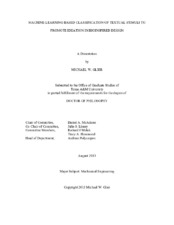| dc.description.abstract | Bioinspired design uses biological systems to inspire engineering designs. One of bioinspired design’s challenges is identifying relevant information sources in biology for an engineering design task. Currently information can be retrieved by searching biology texts or journals using biology-focused keywords that map to engineering functions. However, this search technique can overwhelm designers with unusable results. This work explores the use of text classification tools to identify relevant biology passages for design. Further, this research examines the effects of using biology passages as stimuli during idea generation.
Four human-subjects studies are examined in this work. Two surveys are performed in which participants evaluate sentences from a biology corpus and indicate whether each sentence prompts an idea for solving a specific design problem. The surveys are used to develop and evaluate text classification tools. Two idea generation studies are performed in which participants generate and record solutions for designing a corn shucker using either different sets of biology passages as design stimuli, or no stimuli.
Based 286 sentences from the surveys, a k Nearest Neighbor classifier is developed that is able to identify helpful sentences relating to the function “separate” with a precision of 0.62 and recall of 0.48. This classifier could potentially double the number of helpful results found using a keyword search. The developed classifier is specific to the function “separate” and performs poorly when used for another function. Classifiers developed using all sentences and participant responses from the surveys are not able to reliably identify helpful sentences.
From the idea generation studies, we determine that using any biology passages as design stimuli increases the quantity and variety of participant solutions. Solution quantity and variety are also significantly increased when biology passages are presented one at a time instead of all at once. Quality and variety are not significantly affected by the presence of design stimuli. Biological stimuli are also found to lead designers to types of solution that are not typically produced otherwise. This work develops a means for designers to find more useful information when searching biology and demonstrates several ways that biology passages can improve ideation. | en |


